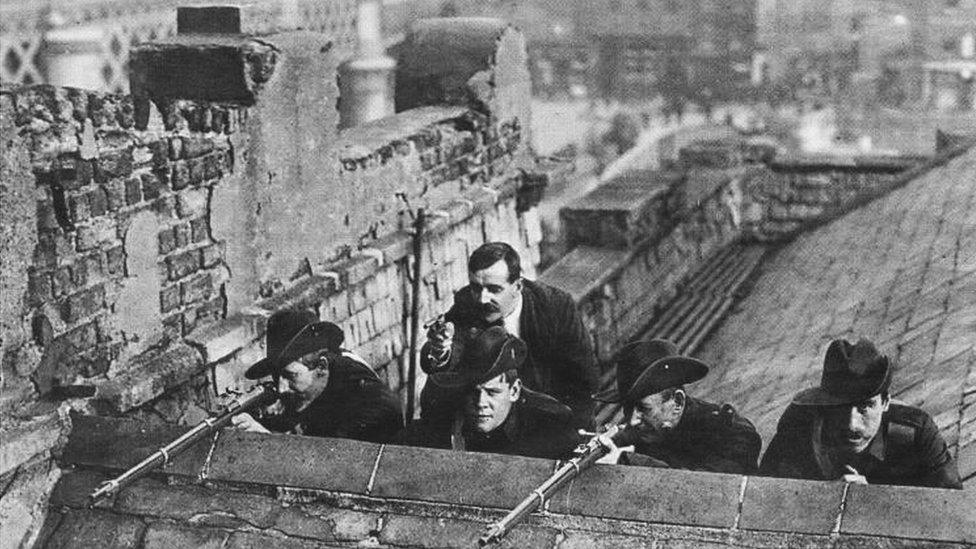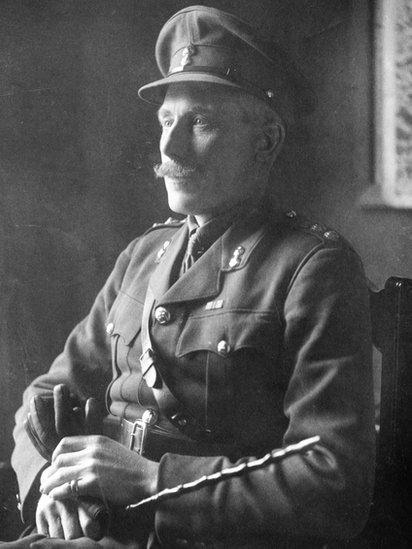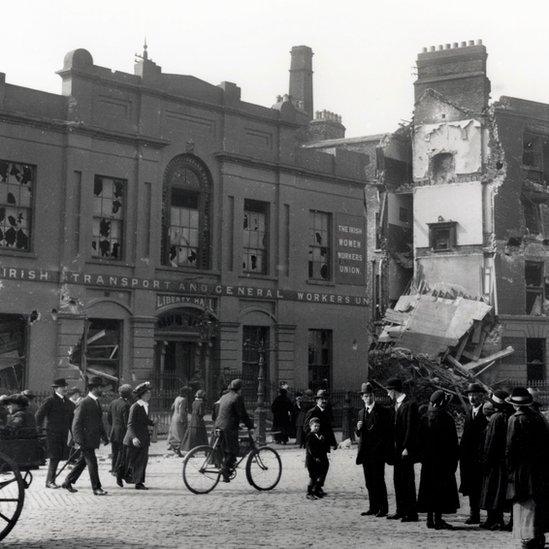1916 Easter Rising: Irish Citizen Army flag returned to Dublin by Enniskillen museum
- Published

The colours of the flag "are as strong as 100 years ago", conservator Rachel Phelan said
A flag found in the ruins of a building where the 1916 Easter Rising was planned has been returned to Dublin.
An uncrowned green harp flag was flown above Liberty Hall by the Irish Citizen Army in the week before the rebellion.
But it was taken by a soldier when the British Army shelled and stormed the building, and it was later given to a military museum in County Fermanagh.
It has now been presented to the Irish president ahead of events to mark the revolt's centenary this weekend.

Irish Citizen Army members kept watch from the roof of Liberty Hall, where the flag was flown
President Michael D Higgins praised the move by the Inniskillings Museum in Enniskillen, saying it was a "magnificent contribution to the 1916 commemorations".
The rising was a short and ill-fated republican rebellion in 1916 against British rule in Ireland.
In spite of its military failure, it is seen by many historians as a significant stepping-stone in the partition of the island and the eventual creation of the Republic of Ireland.
Ceremony
The Irish Citizen Army helped plot the rising and manufactured weapons in Liberty Hall.

Col John McClintock gave the flag to the Inniskillings Museum in 1935, a year before his death
The Proclamation, one of the most important documents in Irish history, was printed in the building the night before the rebellion.
A green harp flag had been hoisted above Liberty Hall on Sunday 16 April 1916 in a ceremony led by James Connolly, the commander of the Irish Citizen Army.
Nine days later, soldiers from the Enniskillen-based Royal Inniskilling Fusiliers arrived in Dublin to quell the rebellion and the next morning an armed patrol yacht opened fire on Liberty Hall in preparation for their assault.
By that stage, the building was virtually empty.
Acting Corporal John McAlonen, a 21-year-old fusilier, retrieved a flag, made from green tabby weave wool with an appliqued yellow wool harp, from the ruins of the hall.
It was presented to the Inniskillings Museum in 1935 by Col John McClintock, who was the commanding officer of the 3rd Inniskillings during the Rising.
Colours
The museum has said months of analysis and research indicate the flag in its possession is the same one flown above the Dublin hall at the time of the rising.
It contacted the current occupiers of Liberty Hall, the Irish trade union SIPTU, and a decision was taken to conserve the flag and loan it for public display.

President Michael D Higgins said the loan of the flag was a "magnificent contribution to the commemorations"
Rachel Phelan, a textile conservator who worked on the flag for several weeks, said it had been "one of the most exciting discoveries to come to light" in her career.
"As it has never been exposed to the light, the strength of the colours are as strong as 100 years ago and the flag would have been clearly visible along the [Dublin] quays," she added.
The Inniskillings Museum said it was "honoured" to loan the "irreplaceable artefact" to SIPTU to put exhibit in Liberty Hall.

Liberty Hall was badly damaged when it was shelled by the Helga patrol yacht